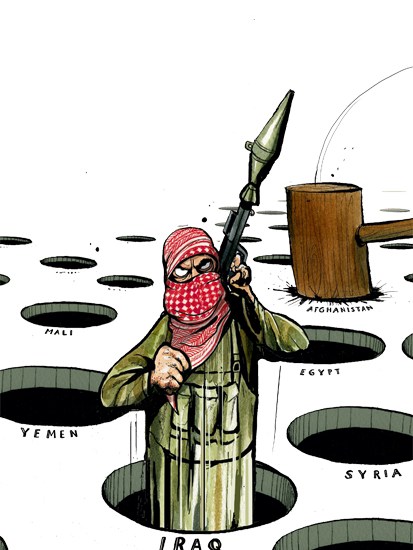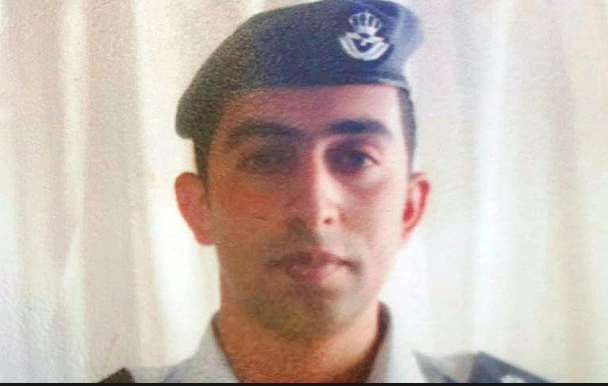Listen
Jihadist banners flying. Victorious extremists on camera slapping and then executing dehydrated and pleading Shia members of the Iraqi security forces. Dark reports of mass slaughter. City charters released in captured territory heralding the implementation of an extreme version of Islamic law. We’ve seen it all before, but it remains shocking — and the latest advance by the Islamic State of Iraq and al-Sham (ISIS) is arguably the most disturbing development in Iraq’s already horrifying recent history.
ISIS has surprised everyone by seizing a number of cities, but its success also raises the question: how long can the group sustain these gains? Media commentators have compared the situation now to the gains made by al-Qa’eda in the Islamic Maghreb, which in 2012 became the dominant force in northern Mali, and was able to enforce harsh religious rule over a broad stretch of territory, about 300,000 square miles. But that group eventually overplayed its hand. When it began to push out from Mali’s borders in January last year, that got everybody’s attention: France, supported by an alliance of West African states, mounted an intervention that dislodged the jihadists and forced many of them into hiding.
Several commentators have noted that ISIS is at risk of a similar overreach. It’s now fighting a multi-front war, across a large expanse of territory, with a limited number of fighters. And ISIS has now triggered a response not only from local players but from the international community too. As Ariel Ahram, an international relations professor at Virginia Tech University, puts it, ISIS’s advance will provoke ‘a re-alignment of political coalitions to resist or even crush it’.
Now, ISIS may not experience reversals as quickly as observers believe — it exhibited impressive staying power after its lightning offensive in January captured large parts of Fallujah and Ramadi — but they’re probably right to say that the group won’t sustain its territorial gains. ISIS has taken on some characteristics of a state — it boasts of being able to provide administrative services to the areas it takes over and of being able to control its troops — yet it doesn’t have a professional military such as many nation-states enjoy. Despite the fearsome rhetoric, ISIS is in no position to capture Baghdad from an Iraqi military that is reinforced by highly trained and heavily armed Shia militias.
It’s tempting to celebrate the failings of these fanatical armies. But it would be a mistake to stop asking what comes next. An examination of what might follow the jihadist groups’ inevitable setbacks shows a disturbing trend.
ISIS is far from the only Islamic extremist movement to control territory and implement a strict version of sharia. Looking at groups that have done so, a clear pattern emerges in which the extremist group gains ground, announces the imposition of sharia, and governs territory. This alarms nearby states, and often those that are further away as well.
So the extremist group’s enemies strike. They topple it from power rather quickly. Although non-state militants are formidable, they have no real response to their enemies’ air-power advantage, and haven’t been able to hold territory against the advance of professional militaries. The extremist group does its best to melt away rather than face a decisive battlefield defeat. It regroups with the intention of coming back stronger than before.
The disturbing thing is the frequency with which militant groups are able to succeed in mounting this comeback.
The first example of an Islamic extremist group seizing and holding most of a country (in the wake of the Afghan-Soviet war, a conflict that forever transformed the jihadist movement) is the Taleban in Afghanistan. The Taleban emerged from the chaos of the civil war that gripped the country after the Soviet-sponsored regime of Mohammad Najibullah collapsed. With Pakistan’s backing, the group came to control about 90 per cent of Afghanistan.
The Taleban became an international concern due to its brutal rule, but ended up in the US’s crosshairs because of its insistence on providing a safe haven for Osama bin Laden and al-Qa’eda. Following the 9/11 attacks, the US quickly dislodged the Taleban through a military campaign. American forces liaised with a local partner, tens of thousands of fighters from the opposition Northern Alliance.
By the end of 2002, many policymakers believed that the Taleban was out for the count — a view that helped prompt the US’s disastrous invasion of Iraq. But after 13 years of costly war in Afghanistan, it’s now widely believed that the Taleban will remain one of the country’s most important players, and it is poised to retake territory in various regions.
Iraq’s jihadist groups are now showing a similar ability to re-emerge stronger after defeat. ISIS’s predecessor, al-Qa’eda in Iraq, was able to exploit the country’s sectarian conflict in 2006-07 to become the dominant force in Anbar province and establish a significant presence elsewhere. (Al-Qa’eda in Iraq bore a great deal of responsibility for the country’s sectarian revenge killings, as its destruction of the al-Askari mosque’s golden dome, a Shia holy site, in February 2006 triggered massive Shia reprisals against Iraq’s Sunnis.)
AQI overplayed its hand in Anbar, prompting an uprising against its influence in the form of the Sahwa (Awakening) movement. The US then deployed its famous ‘surge’, increasing its military commitment and adapting its military strategy. The US moved out of the large forward operating bases where its troops had hunkered down and engaged in counterinsurgency. These converging factors were, at least temporarily, successful in undermining al-Qa’eda’s position, and one can still hear cable news talking heads stating that the group was effectively beaten by late 2008 or 2009.
But claims of victory were premature. Concerns that al-Qa’eda in Iraq could mount a comeback steadily grew in the years that followed. As US forces withdrew from Iraq at the end of 2011, American and Iraqi officials expressed concern that al-Qa’eda was in a good position to mount ‘a deadly resurgence’. As is now clear, these warnings were, if anything, understated.
How have these groups been able to stage such impressive comebacks? Part of the answer lies in the structure of the groups themselves. Many violent non-state actors have sought to ensure their survival by taking on the form of ‘clandestine cellular networks’: clandestine in that they are designed to be out of sight, cellular in that they are compartmentalised to minimise damage when the enemy succeeds in destroying some portion of the network. It is thus difficult to count out a militant group after a state-led offensive forces it to retreat. They are never utterly routed.
Today this pattern — of a militant group’s seizure of territory, followed by a state-led counteroffensive, and militants’ efforts to regroup — is repeating itself in several places. Al-Shabaab, the al-Qa’eda affiliate that once controlled most of southern Somalia, lost its last major urban stronghold of Kismayo to advancing African Union forces in October 2012. Though it hasn’t regained the strength it once enjoyed, Shabaab’s attacks are becoming more sophisticated, most significantly its assault last September on Nairobi’s Westgate Mall that killed 67 and injured at least 175. In late May, the group executed a suicide bombing in Djibouti, and on 15 June it slaughtered at least 48 in a gruesome attack on a coastal Kenyan town, only to strike another coastal town the following day and claim 15 more lives.
Even in Mali, which some see as a classic example of jihadist overreach, there are signs that al-Qa’eda in the Islamic Maghreb is making a comeback. There have been an increasing number of terror attacks carried out on members of the peacekeeping mission in the country. And this pattern may be repeating itself in Yemen, Egypt’s Sinai, and the Caucasus region.
ISIS is not about to consolidate its gains and march onward to capture Baghdad, though it may strike at the capital with a less conventional battle plan. And though ISIS might succeed in holding a handful of cities for an extended period, it is likely to experience a reversal of some sort.
If recent history is any guide, ISIS’s retreat will not mean the group’s death, and we may well see another cycle of retreat-regroup-new offensive. The problem is that this cycle is being repeated in an increasing number of locations, far more than was the case a decade ago. The net effect is growing circles of instability, and an increasingly dangerous world.
Western countries and their regional partners should work together to prevent extremist groups like ISIS from establishing long-lasting states. But they also need to recognise this growing boom-and-bust pattern of instability, and work to address it. Not claiming victory too soon might be a start.
Got something to add? Join the discussion and comment below.
Get 10 issues for just $10
Subscribe to The Spectator Australia today for the next 10 magazine issues, plus full online access, for just $10.
Daveed Gartenstein-Ross is a senior fellow at the Foundation for Defence of Democracies.
You might disagree with half of it, but you’ll enjoy reading all of it. Try your first month for free, then just $2 a week for the remainder of your first year.














Comments
Don't miss out
Join the conversation with other Spectator Australia readers. Subscribe to leave a comment.
SUBSCRIBEAlready a subscriber? Log in